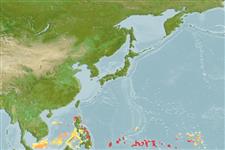>
Acanthuriformes (Surgeonfishes) >
Chaetodontidae (Butterflyfishes)
Etymology: Chaetodon: Greek, chaite = hair + Greek, odous = teeth (Ref. 45335).
Eponymy: Dr Warren E Burgess is an American ichthyologist and research scientist who co-wrote: Dr Burgess’s Atlas of Marine Aquarium Fishes (1988) and the Colored Atlas of Miniature Catfish (1992). [...] (Ref. 128868), visit book page.
Environment: milieu / climate zone / depth range / distribution range
Écologie
marin récifal; profondeur 20 - 130 m (Ref. 90102). Tropical; 19°N - 6°N
Western Pacific: Philippines and northeastern Borneo to Flores and Pohnpei. Recently reported from Tonga (Ref. 53797).
Taille / Poids / Âge
Maturity: Lm ? range ? - ? cm
Max length : 14.0 cm TL mâle / non sexé; (Ref. 9710)
Épines dorsales (Total) : 13; Rayons mous dorsaux (Total) : 18 - 19; Épines anales: 3; Rayons mous anaux: 15 - 16. Body is white with broad diagonal black stripes across the body, the first from the origin of the first dorsal spine to the soft portion of the anal fin, the second from just anterior of the dorsal fin extending postero-ventrally ending at about the level of the pectoral fin, and the third running vertically across the eye from the forehead (Ref. 4855). Snout length 2.8-3.0 in HL. Body depth 1.6-1.7 in SL (Ref. 90102).
Occur in drop-offs where gorgonians and black corals are abundant. Usually in depths over 40 m, but in some localities much shallower (Ref. 48636); usually in depths less than 40 m in East Indian region, solitarily or in pairs (Ref 90102). Reported to have been collected from a depth of 380 feet (= 115.8 m) in Palau (J.C. Delbeek, CAS, pers.comm. 10/2017) . Oviparous (Ref. 205). Form pairs during breeding (Ref. 205). They do well in the aquarium and are exported from the Philippines (Ref. 37816). Maximum depth reported taken from Ref. 128797.
Life cycle and mating behavior
Maturité | Reproduction | Frai | Œufs | Fécondité | Larves
Form pairs during breeding (Ref. 205).
Myers, R.F., 1991. Micronesian reef fishes. Second Ed. Coral Graphics, Barrigada, Guam. 298 p. (Ref. 1602)
Statut dans la liste rouge de l'IUCN (Ref. 130435: Version 2024-1)
Menace pour l'homme
Harmless
Utilisations par l'homme
Pêcheries: commercial; Aquarium: Commercial
Outils
Articles particuliers
Télécharger en XML
Sources Internet
Estimates based on models
Preferred temperature (Ref.
123201): 25.7 - 28.7, mean 28 °C (based on 13 cells).
Phylogenetic diversity index (Ref.
82804): PD
50 = 0.5000 [Uniqueness, from 0.5 = low to 2.0 = high].
Bayesian length-weight: a=0.02291 (0.01133 - 0.04632), b=3.00 (2.83 - 3.17), in cm total length, based on LWR estimates for this Genus-body shape (Ref.
93245).
Niveau trophique (Ref.
69278): 3.5 ±0.37 se; based on food items.
Résilience (Ref.
120179): Haut, temps minimum de doublement de population inférieur à 15 mois (Preliminary K or Fecundity.).
Fishing Vulnerability (Ref.
59153): Low vulnerability (10 of 100).
